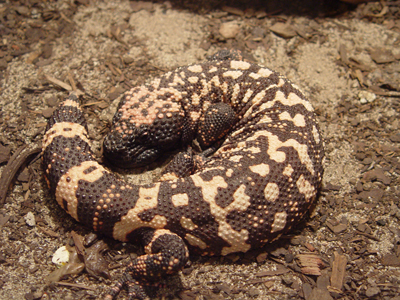



Gila Monster

Name: Gila monster
Size: A heavy, slow-moving lizard, up to 60 centimetres (2.0 ft) long.
Habitat: Found in the Southwestern United States and Mexico, a range entailing Sonora, Sinaloa, Arizona, parts of California, Nevada, Utah, and New Mexico (but not Baja California). They inhabit scrubland, succulent desert, and oak woodland, seeking shelter in burrows, thickets, and under rocks in locations with ready access to moisture. In fact, Gila monsters seem to like water, and can be observed immersing themselves in puddles of water after a summer rain.They avoid living in open areas such as flats and farmland.
Food: The Gila monster feeds primarily on bird and reptile eggs, and occasionally upon small birds, mammals, frogs, lizards, insects, and carrion. The Gila monster eats infrequently (only five to ten times a year in the wild), but when it does feed, it may eat up to one-third of its body mass.It uses its extremely acute sense of smell to locate prey, especially eggs. Prey may be crushed to death if large or eaten alive if small, swallowed head-first and helped down by muscular contractions and neck flexing. Unusually, after food has been swallowed, the Gila monster immediately resumes tongue flicking and search behavior, probably as a result of a history of finding clumped prey such as eggs and babies in nests. Gila monsters are able to climb trees and cacti in search of eggs.
Danger:
Venom is produced in modified salivary glands in the Gila monster's lower jaw, unlike snakes, whose venom is produced in the upper jaw. The Gila monster lacks the musculature to forcibly inject the venom; instead, the venom is propelled from the gland to the tooth by chewing. Capillary action brings the venom out of the tooth and into the victim. Although the venom is a neurotoxin as toxic as that of a Western diamondback rattlesnake, they produces only small amounts. The Gila monster's bite is normally not fatal to adult humans (there are no confirmed reports of fatalities), but it can bite quickly and hold on tenaciously and painfully. If bitten, the victim may need to fully submerge the attacking lizard in water to break free from its bite. Symptoms of the bite include excruciating pain, edema, and weakness associated with a rapid drop in blood pressure.
Some Links to information about Gila Monsters:
- Gila Monsters, DesertUSA.
Photo Credits:
Coral Snake - Blueag9 (GNU Free Documentation License, Version 1.2).The information on this page was taken from Wikipedia under a GNU Free Documentation License unless otherwise noted.









